OUR VEAL PRODUCTS
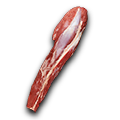 |
Tenderloin
Lean, with a delicate flavour and tenderness
Veal Tenderloin is prepared from the Hindquarter.
The Veal Tenderloin is one of the most tender cuts on the animal. It is lean and therefore needs to be cooked quickly at a high temperature to maintain moisture. Whole tenderloins can be roasted or grilled and barbecued.
|
 |
Tenderloin Denuded
One of the most tender cuts of veal
Veal Tenderloin denuded is prepared from the Veal Tenderloin with the silverskin removed.
The Veal Tenderloin is one of the most tender cuts on the animal. It is lean and therefore needs to be cooked quickly at a high temperature to maintain moisture. Whole tenderloins can be roasted or grilled and barbequed.
|
 |
Tenderloin Portions
Best served medium rare
Veal Tenderloin portions are cut from a Denuded Tenderloin.
Veal Tenderloin Portions are best grilled or barbequed and served medium rare to maintain moisture.
|
 |
Osso Bucco
A traditional winter favourite
Veal Osso Bucco is cut across the bone from either the fore or hind shin into specified portion thicknesses.
|
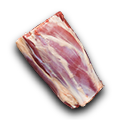 |
Shank
Great for slow cooked applications
Veal Shanks Square Cut are prepared from the muscles that make up the fore and hind legs. The also contain the fore and hind leg bones.
Veal shanks are best braised to soften connective tissue and release flavour from the bone.
|
 |
Shanks Frenched
Frenching helps to improve visual impact on the plate
Veal Shanks frenched are prepared from the muscles that make up the fore and hind legs. The also contain the fore and hind leg bones but differ from the square cut by trimming of the muscles to specified length on the Tibia or the Fore shank bone.
Veal shanks are best braised to soften connective tissue and release flavour from the bone.
|
 |
Osso Bucco
A traditional winter favourite
Veal Osso Bucco is cut across the bone from either the fore or hind shin into specified portion thicknesses.
|
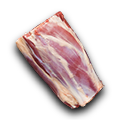 |
Shank
Great for slow cooked applications
Veal Shanks Square Cut are prepared from the muscles that make up the fore and hind legs. The also contain the fore and hind leg bones.
Veal shanks are best braised to soften connective tissue and release flavour from the bone.
|
 |
Shanks Frenched
Frenching helps to improve visual impact on the plate
Veal Shanks frenched are prepared from the muscles that make up the fore and hind legs. The also contain the fore and hind leg bones but differ from the square cut by trimming of the muscles to specified length on the Tibia or the Fore shank bone.
Veal shanks are best braised to soften connective tissue and release flavour from the bone.
|
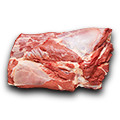 |
Blade
Roasting allows the marbling to infuse in the meat
Veal Blade is prepared from the Forequarter by removing the group of triceps muscles along the natural seam between the scapular and ribs.
Veal blade contains several muscles separated by soft connective tissue. Slow cooking or roasting renders the connective tissue adding flavour and moisture to the finished product.
|
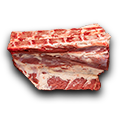 |
Shortloin
A great roasting option
A Short Loin is prepared from a Hindquarter by removing the thin flank and cutting to a specified point along the ribs. The Short Loin consists of the Striploin and Tenderloin and associated bones.
The Veal Shortloin contains the striploin muscles and makes a great roast.
|
 |
Loin Chop
Well marbled, it's tender and full of flavour
Veal Loin is prepared from a carcass side removing the forequarter along the specified rib and the leg , and removing the flank. The chine and feather bone are removed along with the tenderloin.
The Veal Loin chop can also be described as a Veal T-bone due to the T-shaped bone that separates the striploin and tenderloin muscles. This cut is perfect for grilling or barbecuing.
|
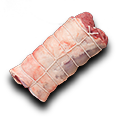 |
Loin Boned and Rolled
Moist and tender when roasted
Veal Loin Boned and Rolled consists of the boneless striploin rolled in the fat layer that covers the Bone In Loin.
Veal Loin Boned and Rolled is great for roasting with the subcutaneous fat layer providing moisture to the underlying eye muscle.
|
 |
Striploin
Best cooked quickly over high heat
Veal Striploin is prepared from the Loin with the flank removed. A denuded Striploin has the subcutaneous fat layer removed.
A denuded striploin has little fat and therefore responds best to quick high heat cooking such as grilling, barbequeing or stir frying.
|
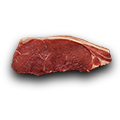 |
Striploin Steak
Tender and succulent, and best cooked fast over high heat
Veal Striploin steaks are cut from a Boneless Striploin.
Striploin steaks are best cooked quickly to a high heat using methods such as grilling, barbequeing or stir frying.
|
 |
Backstrap or Eye of Loin
As tender as the tenderloin
The Backstrap consists of the loin muscle known as the longissimus dorsi that runs along the inside of the spine. The Eye of Loin is cut from the loin portion of the Backstrap.
Veal backstrap has little fat and therefore responds best to quick high heat cooking such as grilling, barbequeing or stir frying.
|
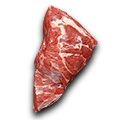 |
Rump
Best when pan or shallow fried
Veal Rump can either be removed from the leg set along its natural seam or from the Sirloin Butt.
|
 |
Mince
A versatile all rounder
Veal Leg Mince is great for bolognese, meatballs and adding to fillings for stuffing.
|
 |
Short Ribs
Short Ribs perform best when cooked slowly in liquid
Veal Short Ribs are prepared from the Rib Set and are cut from the middle portion of the ribs. They contain the muscles overlying the rib cage.
Short ribs can either be cooked whole or cut into individual portions and produce the most tender and flavoursome meat when cooked slowly in moist conditions.
|
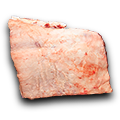 |
OP Rib (Rack)
Roasting with the bone in amplifies the flavour
Ribs prepared are prepared from a rib set (by the removal of the short ribs). The chine bone is removed, exposing the meat but leaving the feather bones attached. The ligamentum nuchae (paddy whack) is removed.
Veal OP Rib produces a great roast due to the flavours released when cooking on the bone.
|
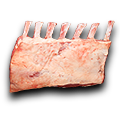 |
OP Rib Frenched (Rack)
A very tender cut
The Veal OP Rib frenched consists of the OP Rib with the removal of the intercostals to a specified point on the rib bones.
A Frenched Veal OP Rib looks and tastes fantastic as a roast.
|
 |
Rib Cutlets Frenched
Tender and flavoursome when grilled
Veal Rib cutlets are cut from the OP Rib and contain the Cube Roll muscles as well as a rib bone.
Veal Ribs Cutlets contain the cube roll which is tender and flavoursome. Cutlets are best cooked on the grill or barbecue.
|
 |
Topside Schnitzel
Ideally suited for schnitzels or escalopes for pan frying
The Topside is removed from the leg set along its natural seam. The Cap is removed and the primal is sliced into portions.
Veal Topside Portions are best suited for schnitzels and can be pan or shallow fried.
|
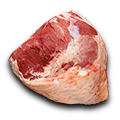 |
Topside
A lean cut suited for roasting, or often portioned into steaks
Veal Topside can be a dry cut and therefore care needs to be taken when roasting. When diced, Topside is great in slow moist cooked meals.
|
 |
Outside Flat
Ideally suited to slow cooking methods
The Veal Silverside is removed from the Leg set along its natural seam. The Outside Flat is then prepared from the Silverside by removal of the Eye Round.
Veal Silverside contains little fat and can be tough if cooked too quickly. Slow moist cooking methods maintain the moisture and aids the tenderness of this cut.
|
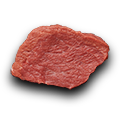 |
Outside Flat Schnitzel
Great for crumbed schnitzels
The Veal Silverside is removed from the Leg set along its natural seam. The Outside Flat is then prepared from the Silverside by removal of the Eye Round.
Veal Outside Flat Portions are best suited for schnitzels and can be pan or shallow fried.
|
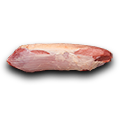 |
Eye Round
Versatile with a mild flavour
The Veal Eye Round is prepared from the Silverside by removal of the Outside Flat.
his cut can be very lean but is suitable for roasting or slow moist cooking methods such as braising.
|
 |
Chuck Roll
Use slow, low cooking methods to deliver the best flavour and tenderness
Veal Chuck Roll is prepared from the Chuck by removal of the neck.
Veal Chuck Roll contains a lot of connective tissue due to the amount of work the shoulder muscles do on the animal. Slow cooking renders the connective tissue down to add flavour.
|
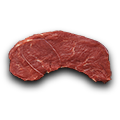 |
Knuckle Schnitzel
Extremely flavoursome and firm in texture
Veal Knuckle is prepared from the leg set by removal along its natural seam.
Like the other leg set muscles the Veal Knuckle is suitable for portioning for schnitzel.
|
 |
Blade Boned and Rolled
A moist and flavoursome roast
Veal Blade is prepared from the Forequarter by removing the group of triceps muscles along the natural seam between the scapular and ribs.
The bones and connective tissue are removed before rolling and trussing. Veal blade contains several muscles separated by soft connective tissue. Slow cooking or roasting renders the connective tissue adding flavour and moisture to the finished product.
|
 |
Blade Diced
Full of flavour
Veal Blade is prepared from the Forequarter by removing the group of triceps muscles along the natural seam between the scapular and ribs.
Diced Veal forequarter is great for casseroles or braising.
|
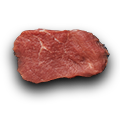 |
Scallopini
Perfect for pan frying
The Veal Eye Round is prepared from the Silverside by removal of the Outside Flat.
Due to its consistent round shape the Veal Eye Round is great for portioning for scallopini.
|
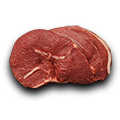 |
Rump Steaks
Sweet and rich in flavour
Veal Rump can either be removed from the leg set along its natural seam or from the Sirloin Butt.
Veal rump muscles generally do less work than the other leg set muscles and are therefore more tender. Veal Rump portions are suitable for quick, high heat cooking methods such as grilling or barbecuing.
|
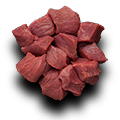 |
Chuck Diced
A great addition to stews and casseroles
Veal Chuck Roll is prepared from the Chuck by removal of the neck.
When diced, this cut is a great addition to stews and casseroles.
|



